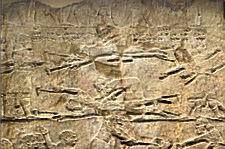Home Quiz
Nahum: Week 1
Modified Historical Method
While scholars provide valuable insights on the ancient world, secular
scholars are useless for dating prophetic literature, as they are compelled to
move the date forward against all other evidence as eloquently stated by
Bart Erhman:
This isn’t simply the approach of “liberal” Bible professors. It’s the way
historians always date sources. If you find a letter written on paper that is
obviously 300 years old or so, and the author says something about the
“United States” — then you know it was written after the Revolutionary War.
So too if you find an ancient document that describes the destruction of
Jerusalem, then you know it was written after 70 CE. It’s not rocket science!
But it’s also not “liberal.” It’s simply how history is done. If someone
wants to invent other rules, they’re the ones who are begging questions!
Thus secular scholars date Nahum after the destruction of Nineveh - as
the description in chapter 2 and 3 reads like an eyewitness account.
For dating Nahum, we use a modified historical method that takes prophecy
at face value. Nahum 3:8-10
mentions the destruction of Thebes (No-Amon) by Ashurbanipal II as a past
event, so it was written after 663 BC. The entire book foretells the
destruction of Nineveh by the coalition led by Nabopolassar in 612 BC,
narrowing it to a span of 50 years. Thebes was rebuilt in 654, leaving
a span of 10 years. Furthermore, chapter 1 portrays Assyria at the height
of power - seemingly invincible, and the decline of the empire was very
evident by 626.
 This was the case during the reign of Manasseh in Judah described in
2 Chronicles 33.
Manesseh was taken to Babylon in 648 BC, when Ashurbanipal II temporarily
reigned there after eliminating his brother, Samas-sumu-ukin.
In 33:11-13,
Manasseh is taken away for interrogation, and is "distressed" - i.e. tortured -
by the King of Assyria. But even this great evil resulted in the salvation
of Manasseh!
This was the case during the reign of Manasseh in Judah described in
2 Chronicles 33.
Manesseh was taken to Babylon in 648 BC, when Ashurbanipal II temporarily
reigned there after eliminating his brother, Samas-sumu-ukin.
In 33:11-13,
Manasseh is taken away for interrogation, and is "distressed" - i.e. tortured -
by the King of Assyria. But even this great evil resulted in the salvation
of Manasseh!
In the relief to the right, two Elamites are being skinned alive during
the time of Ashurbanipal.
Dragging someone off with hooks in their nose would be in keeping with
Ashurbanipal’s character. In the excavations of Sam’al (Zincirli, in southern
Turkey) a stela was found depicting Esarhaddon holding two leashes attached to
the nose-rings of Baal of Tyre and Usanahuru, a crown prince of Egypt (see
front cover). Flanking the stela, watching intently, is Esarhaddon’s son
Ashurbanipal on the left and his brother Samas-sumu-ukin on the right.
Ashurbanipal observed his father’s brutality and followed his example.
(Parpola and Watanabe 1988:20, 21) as quoted in
Associates for Biblical Research
Manasseh names his son after Amon, an Egyptian god. Since Egypt
seemed to be resisting Assyrian rule, their gods must be powerful!
 This was the case during the reign of Manasseh in Judah described in
2 Chronicles 33.
Manesseh was taken to Babylon in 648 BC, when Ashurbanipal II temporarily
reigned there after eliminating his brother, Samas-sumu-ukin.
In 33:11-13,
Manasseh is taken away for interrogation, and is "distressed" - i.e. tortured -
by the King of Assyria. But even this great evil resulted in the salvation
of Manasseh!
This was the case during the reign of Manasseh in Judah described in
2 Chronicles 33.
Manesseh was taken to Babylon in 648 BC, when Ashurbanipal II temporarily
reigned there after eliminating his brother, Samas-sumu-ukin.
In 33:11-13,
Manasseh is taken away for interrogation, and is "distressed" - i.e. tortured -
by the King of Assyria. But even this great evil resulted in the salvation
of Manasseh!